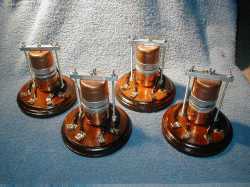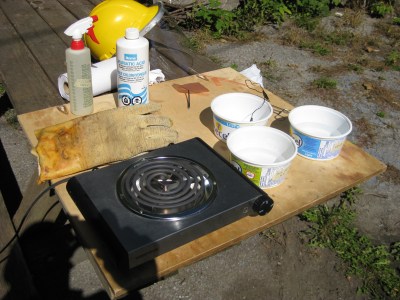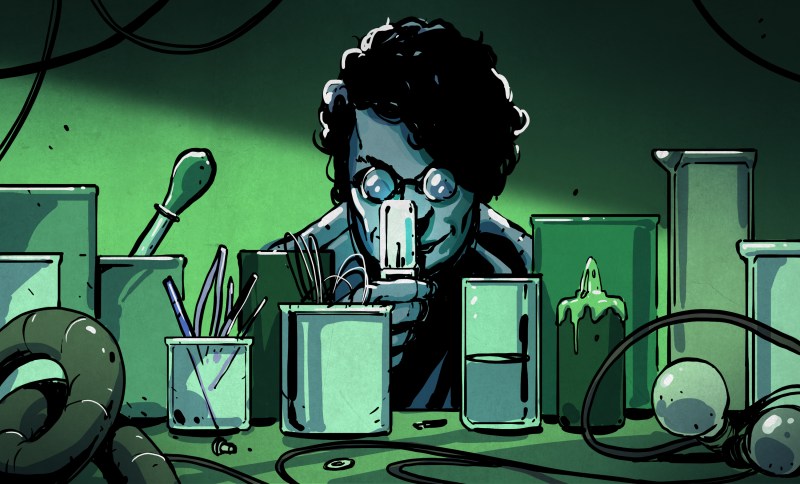Psst… Wanna make a canning jar diode? A tennis ball triode? How about a semiconductor transistor? Or do you just enjoy sitting back and following along an interesting narrative of something being made, while picking up a wealth of background, tips and sparking all sorts of ideas? In my case I wanted to make a cuprous oxide semiconductor diode and that lead me to H.P. Friedrichs’ wonderful book Instruments of Amplification. It includes such a huge collection of amplifier knowledge and is a delight to read thanks to a narrative style and frequent hands-on experiments.
Friedrichs first authored another very popular book, The Voice of the Crystal, about making crystal radios, and wanted to write a second one. For those not familiar with crystal radios, they’re fun to make radios that are powered solely by the incoming radio waves; there are no batteries. But that also means the volume is low.
Readers of that book suggested a good follow-up would be one about amplifier circuits, to amplify the crystal radio’s volume. However, there were already an abundance of such books. Friedrichs realized the best follow-up would be one on how to make the amplifying components from scratch, the “instruments of amplification”. It would be unique and in the made-from-scratch spirit of crystal radios. The book, Instruments of Amplification was born.
The Experiments

The book includes just the right amount of a history, giving background on what an amplifier is and how they first came in the electrical world. Telegraph operators wanted to send signals over greater and greater distances and the solution was to use the mix of electronics and mechanics found in the telegraph relay. This is the springboard for his first project and narrative: the microphonic relay.
The microphonic relay example shown on the right places a speaker facing a microphone; the speaker is the input with the microphone amplifying the output. He uses a carbon microphone salvaged from an old telephone headset, housing everything in an enclosure of copper pipe caps, steel bar stock, nuts and bolts mounted on an elegant looking wood base. All the projects are made with simple parts, with care, and they end up looking great.

The adventure continues with a balance-beam amplifier (using two sewing bobbins to wrap the coils on, carbon from an old flashlight and counterweight from old clock gears), a needle box transformer (necessitating an explanation of Ohm’s law and Thevenin’s Theorem), and arrives at The Vacuum Tube. Of course you can’t understand vac tubes without a discussion of the atom, thermionic emission, and the thermionic diode and triode.
The semiconductor doesn’t get left out in the cold either. Friedrichs takes the time to explain point-contact transistors using germanium crystals taken from old germanium diodes. If that’s not made-from-scratch enough, he has a few chapters experimenting with copper sheets to produce cuprous oxide which is where my interest lies.
Making a Cuprous Oxide Semiconductor Diode

I originally bought this book, to make a cuprous oxide semiconductor diode. In the photo you can see my setup during one day of experimenting. The jar in the back contains hydrochloric acid, available in hardware and pool stores as muriatic acid, and hence the splash visor and safety gloves.
The process uses borax (a household cleaner) to first clean the copper. Next the stove element is used to heat the copper along with the acid, forming the desired cuprous oxide layer as well as a cupric oxide on top of that which needs to be removed.
Unfortunately I didn’t succeed in producing any diode-like activity. That is certainly not a failing of the book. I spent only two days experimenting and ran out of time. It’s amazing to me that Friedrichs managed to make these rather involved topics so approachable that I could try this with easy to obtain ingredients. And I do hope to return to it someday.
This is a fantastic book for anyone who wants to get their hands dirty actually building vacuum tubes or who wants to try their hand at a semiconductor transistor or experiment with making any old-school amplifier component. But even if you don’t take on the experiments yourself there is a wealth of knowledge to be learned just by reading the background and watching the approach used for each build. I highly recommend this book. On these topics it is indispensable.
Do you have a similarly awesome book to you to recommend? Let us know in the comments below.



















Caveman Chemistry is an entertaining read.
The Boy Electrician has a number of interesting projects, like winding your own transformer, dynamo & every other state of the art piece of equipment ca 1913. It’s public domain now too so don’t feel bad downloading a PDF from the web.
Warning, Safety pet peeve below:
Face shields are not complete without safety goggles underneath. None of their ratings are valid without goggles also worn.
/safety police
The Boy Electrician looks very familiar. When I was a kid (late 80s, early 90s) I read everything I could get about electronics from the local village and school libraries. It was horrible. Now don’t get me wrong, I actually believe that learning about older technology is a good thing. It helps you to understand how things work on a deeper level. Also, what no longer makes sense to do in an industrial factory might still be a good trick for the home hobbyist. But.. you don’t want that stuff to be a beginner’s only source of information. Those books made it all sound so easy to build things yourself.. just hop down to the basement and pick a piece of galena from the coal pile or jog down to the drug store and pick up some vacuum tubes. Yah Right, like that still existed! It amazes me that anyone at all grew up during that time (80s, 90s) and became any sort of maker. It was so discouraging! Well.. maybe more urban places had better resources, maybe their libraries stocked newer books and they had Radio Shacks with more complete parts inventories. Maybe…
Anyway.. yes.. I recognize this book. It was actually one of the better among the school library connection. I guess because it was so primitive that the necessary parts to build the projects were more like raw materials. There isn’t a single reference to a drug-store vacuum tube or a automotive condenser in there. Wow, it even talks about Aether! I forgot about that!
Anyway.. yah, reading this is a good idea. Doing so or maybe even building some of the projects contained within will definitely teach you some good stuff that you will not learn blinking lights with an Arduino. I’m just so glad that this kind of thing no longer has to be anyone’s sole source of information! It’s such a great reminder of why I love the Internet.
Oh.. and you probably don’t want to mess with building the big spark gap transmitter. Or, at least don’t attach an antenna to it. Not everything that was normal in 1913 is even legal today.
Don’t have a lump of galena in the basement? No problem, you can make your own substitute cats whisker ‘crystal’ from first principles using a piece of lead and some sulphur!
Here’s a page from an old Australian ‘Hobbies Illustrated’ magazine from 1947 which shows you how to do it:
http://www.surfacezero.com/g503/uploads/612/Novelty_Crystal_Pencil_Radio_with_homemade_crystal_Hobbies_Illustrated_1947.jpg
This can become also more and more difficult, as lead is banned from more and more applications.
Except vehicle batteries, ammunition, roof flashing…
No, quite easy. A tire shop or or motor garage will usually have lead weights for wheel balancing, and sometimes they can be found along the side of the road.
I’m guessing based on the existance of this article that in the 1940s sulphur had some common household use so a kid could find it in their home or at least buy it at the local drug store. Had I read this article as a kid I don’t think I would have been any more excited about it than I was for articles that told me to dig galena out of my basement coal pile. Where the heck would I have obtained sulphur? Maybe in dry areas with lots of exposed rocks a kid could just go find it outside? Where I grew up glaciers deposited about a mile of clay over the top of anything like that a long time before I got there. Maybe I should have taken up pottery.
What would have worked is an article about using a graphite pencil and a rusty razor blade. For some reason none of the local library books had anything about foxhole radios. They only carried stuff that was way too dated to be usable.
Of course these days if a kid wants sulphur, galena or practically anything else all they need is an adult with a PayPal account who is willing to help them out. It’s a much better world now! I suppose though that not every child has such an adult in their lives… My own daughter certainly does!
I don’t know about the 1940s but in the 1970s I bought sulphur at our local drug store. If I recall correctly I also bought saltpeter there too. I don’t know what they were normally used for. The charcoal came from my father’s bag for barbequing. And of course together they made gunpowder, which I used to spectacularly burn miniature homemade spacecraft.
Sulfur is commonly used in gardening to lower the pH of soil. Shouldn’t be too difficult to find these days.
It can also be generated from the gasses that come of anaerobic decomposition by heating those gases in the presence of hydrogen which you can create via electrolysis and the NaOH for that can be made from NaCl. You also get several other useful products in the process, such a chlorine gas.
https://en.wikipedia.org/wiki/Claus_process
https://en.wikipedia.org/wiki/Electrolysis_of_water
https://en.wikipedia.org/wiki/Sodium_hydroxide#Production
https://en.wikipedia.org/wiki/Hydrogen_chloride#Direct_synthesis
Books you should read:
Interfacing Sensors to the IBM PC / Prentice Hall / 1988
cheap (amazon used condition A+ 0,01 US$ !)
Great read as it is a book about sensors and measurements – and for the smaller part interfacing the ibmpc bus.
https://www.amazon.com/gp/offer-listing/0134690818/ref=dp_olp_all_mbc?ie=UTF8&condition=all
The long, long gone ISA bus, along with the serial and parallel ports. You’d be better interfacing through an Arduino nowadays.
Back in the late 90s I visited a friend at MTU (Michigan Tech). I was lucky to get there at a day where different student groups that built things were showing off their projects. There was one which was controlled by computer motherboards interfaced via the ISA bus. I don’t remember exactly what it was, probably some sort of robot or something. I was totally floored by the fact that they managed to use the ISA bus! Previously I had no idea that it was possible for a ‘mere mortal’ outside of the big hardware producing companies to do that.
Today building something that connects via ISA bus is still on my ‘project bucketlist’. I will not throw away my last motherboard w/ an ISA bus until I have done it at least once. But.. I’m also in no particular hurry to start that project. I guess I will probably be wasting space, storing an old motherboard for the rest of my life.
Essentially you just need some buffering and address decoding.
Dirt simple ways to meddle might be hacking old I/O cards and modems. Modems won’t give you much but I/O cards, the IDE data bus apart from the control goes right on the ISA data bus, so rejig addresses and IRQs and you’ve got most of it broke out on the pin header.
It had it’s last gasp around the time of ghz CPUs, so you can get up a linux box that will have a reasonable turn of speed to run your project. If you really need ooomph, then find an early socket A board with ISA that can be volt modded and BIOS modded to run one of the later Thoroughbred B chips, which you could squeeze 2.5Ghz out of. RAM could be an issue, if you’re going to need much, 2GB would be on the hard to arrange end. 512 or 768 being a normal high amount on this era.
Also available is stuff like the K8055RS USB Interface by Velleman, I grabbed one of those through surplus channels the other month.
http://elm-chan.org/works/pci/report_e.html
There was documentation on the ISA bus back then. Agree with RW, ISA is simple, in fact too simple for high/reasonable performance. … On a side note, I keep documentation on old technology, tubes, etc., but don’t build with it for the sake of making an antique, make for function.
Bus is still common on PC/104 boards.
Both books look fascinating. However, I was nonplussed by the fact that his site has no links to Amazon or anywhere else where one can purchase the books. In case anyone is interested:
Instruments of Amplification
https://www.amazon.com/dp/0967190517/
Voice of the Crystal
https://www.amazon.com/dp/0967190509/
If you are in UK and look for the book on amazon.co.uk, it’s only available used through third parties at an inflated cost. Thanks to an amazon reviewer, I found it direct (and new) direct at http://www.pwpublishing.ltd.uk/historical/ I’ve no connection to the publisher but I’m looking forward to getting the book – thanks for the review.
FYI: Dealers can be found here:
http://hpfriedrichs.com/mybooks/bks-buyit.htm
He does have a page about buying his books, and it lists Amazon first among many other stores / websites.
Not directly related, but one I learn something different from every time I pick it up:
Reference Data for Radio Engineers, H.W Sams & Co.
Recent editions are titled “Reference Data for Engineers” This book has been published since 1943, and is periodically updated with new stuff (now on 9th edition). A true engineer’s handbook, it’s really packed with interesting and useful data, tables, diagrams, and explanations of myriad topics in electronics. Current printings are $100+ (the Kindle edition is $200!), but you can find used ones for a few dollars (https://www.amazon.com/Reference-Data-Radio-Engineers-Howard/dp/0672212188/ref=sr_1_1?ie=UTF8&qid=1469123889&sr=8-1&keywords=reference+data+for+radio+engineers). I have one from 1977 (Sixth Ed.) and 1998 (Eighth Ed.) – both purchased in 2012.
Procedures In Experimental Physics – John Strong. Dated, but amazing and free on archive.org
Scientific American Amateur Scientist – Much missed column, collected by tinkers guild on CD but now out of print. There are also some books collecting some of the projects.
The Design of the UNIX Operating System by Maurice J Bach.
TCP/IP illustrated by Stevens.
Helicopter Performance Stability and Control by Prouty
High Security Mechanical Locks by Pulford
http://www.tubebooks.org/
Babani electronics books, this is a fraction of what has been available, look out for them used… http://www.babanibooks.com/bb7.htm
Paladin picked up some of the old Loompanics titles, few electronic ones here…
http://www.paladin-press.com/category/Espionage_and_Investigation
There may be some original Loompanics stock hanging round at other sellers.
Then respectable folks, like McGraw-Hill have the TAB Electronics line of books that have had many fascinating titles.
Boy, I wish I could read!
You smart-ass. :D
If typing a comment does not require the ability to read a comment then the Internet just started making a lot more sense!
I have a book that explains ‘static’ electricity and has plans for a Wimshurst generator, among other things…
Homemade Lightning: Creative Experiments in Electricity
I have the same one. On the various ‘static’ electricity related forums it’s probably the one that comes up the most. Another good one by the same author, Robert E. Iannini (who also has a well known HV electronics supply online store which I’ve bought stuff from over the years http://www.amazing1.com/), is Build Your Own Laser, Phaser, Ion Ray Gun & Other Working Space-Age Projects.
The Golden Book of Chemistry Experiments offers instructions for distilling ethanol, generating chlorine gas, nitric and sulfuric acids, as well as purifying ammonia and iodine; everything a curious boy needs to get through junior high. The complete collection of Scientific American Amateur Scientist columns is available on CD. Theo Gray’s Mad Science book another fav.
There is also a book of 50 experiments based on that publication, https://archive.org/details/TheAmateurScientist